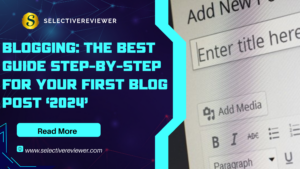Introduction to Blogging
Blogging has become an integral part of the online world today. It provides a platform to express your thoughts, share your expertise, and connect with a wider audience. Whether you are an aspiring writer, a business professional, or just someone who wants to share their experiences, blogging is an effective way to communicate your ideas. In this step-by-step guide, I will walk you through the process of writing your first blog post and help you master the art of blogging to change your life.
Why is Writing Your First Blog Post Important?
Your first blog post is crucial as it sets the tone for your blog and establishes your voice as a writer. It is the first impression that your readers will have of your blog, so it’s important to make it engaging and informative. Writing a compelling first blog post will not only grab the attention of your readers but also encourage them to explore your other content and become loyal followers. Additionally, writing your first blog post allows you to define your niche, clarify your goals, and establish your blog’s identity.
Planning and Brainstorming Your Blog Post
Before diving into writing your first blog post, it’s essential to plan and brainstorm ideas. Start by identifying your target audience and understanding their interests and pain points. This will help you tailor your blog post to their needs and make it more relatable. Next, brainstorm topics that align with your niche and appeal to your audience. Consider what unique perspective or expertise you can bring to the table. Write down all your ideas and choose the one that resonates with you the most.
Choosing the Right Topic for Your First Blog Post
Choosing the right topic is crucial for your first blog post. It should be something you are passionate about and have enough knowledge to write confidently. Your topic should also be relevant to your target audience and address a specific problem or provide valuable information. To further refine your topic, conduct keyword research using tools like Google Keyword Planner or SEMrush. Look for keywords that have a decent search volume and low competition. This will help optimize your blog post for search engines and attract organic traffic.
Researching and Gathering Information for Your Blog Post
Once you have chosen your topic, it’s time to gather information and conduct thorough research. Start by reading books, articles, and credible online sources related to your topic. Take detailed notes and bookmark valuable resources for future reference. Interview experts or individuals who have experience in your chosen topic to gather unique insights. Remember to cite your sources properly to give credit where it’s due. The more research you do, the more comprehensive and authoritative your blog post will be.
Structuring Your Blog Post – Introduction, Body, Conclusion
A well-structured blog post is essential for readability and engagement. It should have a clear introduction, informative body, and a compelling conclusion. In the introduction, grab your readers’ attention with a captivating hook and provide a brief overview of what they can expect from your blog post. The body should be divided into logical paragraphs, each focusing on a specific subtopic or point. Use headings and subheadings to break down your content and make it easier to skim. Finally, wrap up your blog post with a strong conclusion that summarizes the main points and leaves your readers with a lasting impression.
Writing Your First Blog Post – Tips and Techniques
Now that you have a solid structure in place, it’s time to start writing your first blog post. Here are some tips and techniques to help you write an engaging and well-crafted blog post:
- Write in a conversational tone: Make your blog post relatable by writing in a conversational tone. Imagine you are having a conversation with your readers and convey your thoughts naturally.
- Use storytelling techniques: Weave storytelling elements into your blog post to make it more captivating. Share personal anecdotes, case studies, or real-life examples that resonate with your readers.
- Keep it concise and focused: Avoid rambling or going off-topic. Keep your sentences and paragraphs concise, and stay focused on delivering valuable information to your readers.
- Use bullet points and numbered lists: Break down complex information into easy-to-digest bullet points or numbered lists. This makes your blog post more scannable and reader-friendly.
- Add a call-to-action: End your blog post with a clear call-to-action (CTA) that encourages your readers to take the desired action, such as subscribing to your newsletter or leaving a comment.
Formatting and Optimizing Your Blog Post for SEO
To ensure your blog post reaches a wider audience, it’s important to format and optimize it for search engines. Here are some key SEO practices to follow:
- Use relevant keywords: Incorporate your primary and secondary keywords naturally throughout your blog post. However, avoid keyword stuffing, as it can negatively impact your search engine rankings.
- Write a compelling meta description: Craft an enticing meta description that accurately summarizes your blog post and encourages users to click through to your website.
- Optimize your headings: Use H1, H2, and H3 tags to structure your content and highlight important sections. Include relevant keywords in your headings to improve SEO.
- Add alt tags to images: When adding images to your blog post, include descriptive alt tags that contain relevant keywords. This helps search engines understand the content of your images.
- Interlink your content: Link to other relevant blog posts or pages within your website to improve navigation and increase page views. This also helps search engines crawl and index your content more effectively.
Adding Visuals and Multimedia to Enhance Your Blog Post
Incorporating visuals and multimedia elements can greatly enhance the visual appeal and engagement of your blog post. Here are some ideas to consider:
- Include high-quality images: Use relevant and visually appealing images that complement your content. Ensure that the images are properly optimized for web use to avoid slowing down your website.
- Embed videos: If applicable, consider embedding videos that provide additional value or demonstrate a concept related to your blog post. Videos can enhance the overall user experience and keep visitors engaged.
- Infographics and charts: If you have data or statistics to present, consider creating informative infographics or charts. Visual representations of information are often easier to understand and more shareable.
- Slide decks or presentations: If your blog post covers a complex topic, consider creating a slide deck or presentation that can be embedded or linked to from your blog post. This allows readers to explore the content in a more interactive and visually appealing format.
- Audio clips or podcasts: If you prefer audio content, consider including audio clips or embedding podcasts relevant to your blog post. This provides an alternative listening experience for your audience.
Editing and Proofreading Your Blog Post
Before publishing your first blog post, it’s crucial to edit and proofread it thoroughly. Here are some tips to ensure your post is error-free and polished:
- Read out loud: Reading your blog post out loud can help you identify awkward sentence structures, grammatical errors, and typos.
- Take a break: Step away from your blog post for a while and come back with fresh eyes. This will help you spot any mistakes or areas that need improvement.
- Use editing tools: Utilize online editing tools like Grammarly or Hemingway Editor to catch grammatical errors, improve sentence structure, and enhance readability.
- Check for consistency: Ensure that your writing style, tone, and formatting are consistent throughout the blog post. Inconsistencies can distract readers and make your post appear unprofessional.
- Get a second opinion: Ask a friend, colleague, or fellow blogger to proofread your blog post. Another set of eyes can catch errors that you might have missed.
Publishing Your First Blog Post on WordPress
If you have chosen WordPress as your blogging platform, publishing your first blog post is a straightforward process. Here’s a step-by-step guide to help you:
- Log in to your WordPress dashboard.
- Click on “Posts” and then “Add New” to create a new blog post.
- Write your blog post content in the visual or text editor provided.
- Add relevant headings, subheadings, and formatting to structure your content.
- Insert images, videos, or other multimedia elements to enhance your blog post.
- Preview your blog post to ensure everything looks as intended.
- Once satisfied, click on “Publish” to make your blog post live on your website.
Promoting and Sharing Your First Blog Post
Writing your first blog post is just the beginning. To reach a wider audience and gain traction, you need to promote and share your blog post effectively. Here are some strategies to consider:
- Share on social media: Share your blog post on your social media platforms, such as Facebook, Twitter, LinkedIn, or Instagram. Craft compelling captions and use relevant hashtags to increase visibility.
- Engage with online communities: Join relevant online communities, forums, or groups related to your blog’s niche. Share your blog post and engage in discussions to establish yourself as an authority and drive traffic to your website.
- Email marketing: If you have an email list, send out a newsletter to your subscribers highlighting your latest blog post. Include a brief teaser and a direct link to encourage click-throughs.
- Guest blogging: Reach out to other bloggers or websites in your niche and offer to write a guest blog post. Include a link to your first blog post in your author bio or within the content, if relevant.
- Comment on other blogs: Leave thoughtful comments on other blogs related to your niche. Include a link to your blog post only if it adds value to the discussion. Avoid spammy or self-promotional comments.
Analyzing and Measuring the Success of Your First Blog Post
To gauge the success of your first blog post and make data-driven decisions, it’s important to analyze and measure its performance. Here are some key metrics to track:
- Website traffic: Monitor the number of visitors to your website and the specific page views for your first blog post. This will give you an indication of how well your post is attracting readers.
- Engagement metrics: Look at metrics like time on page, bounce rate, and social shares to understand how engaged your readers are with your blog post. Higher engagement indicates that your content is resonating with your audience.
- Conversion rates: If you have specific goals for your blog post, such as newsletter sign-ups or product sales, track the conversion rates to measure the effectiveness of your call-to-action.
- Feedback and comments: Pay attention to the feedback and comments you receive on your blog post. This can provide valuable insights into what resonates with your audience and help you improve future content.
Examples of Great First Blog Posts
To inspire and guide you further, here are some examples of great first blog posts:
- “How I Overcame My Fear of Public Speaking and Became a Confident Speaker” – This personal story highlights a common fear and provides actionable tips for overcoming it.
- “10 Essential Tools Every Home Cook Should Have in Their Kitchen” – This blog post combines personal expertise with practical advice for aspiring home cooks.
- “The Ultimate Guide to Traveling on a Budget: How I Explored 10 Countries in 6 Months” – This comprehensive guide shares personal experiences and valuable tips for budget travelers.
Conclusion
Writing your first blog post may seem like a daunting task, but with proper planning, research, and the right techniques, you can create a compelling and impactful piece of content. Remember to choose a topic you are passionate about, conduct thorough research, and structure your blog post in a reader-friendly manner. Utilize formatting and optimization strategies to improve SEO, and don’t forget to promote and share your blog post to reach a wider audience. By following this step-by-step guide, you’ll be well on your way to mastering the art of blogging and creating engaging content that resonates with your audience.
Start your blogging journey today and unleash your creativity!


















Add comment